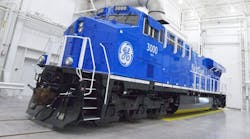In the 2014 edition of the yearly Annual Energy Outlook report compiled by the Energy Information Administration (EIA), several new trends – from shifts in driving demographics to wider usage of natural gas, especially by freight railroads – is expected to generate big changes for the U.S. transportation sector in the years ahead.
Perhaps the biggest trend from EIA’s perspective is a 6% reduction in its U.S. population projection for 2040 compared to the numbers used in its 2013 report – a change based on new U.S. Census data that includes a lower projection for net international migration, with younger age groups showing the largest differences from the earlier projection.
The agency noted that the slower rate of population growth leads to less labor force growth, which contributes to slower gross domestic (GDP) growth for the nation.
Some of the big “macroeconomic” shifts predicted by the EIA where energy is concerned include:
- Growing domestic production of natural gas and oil will continue to reshape the U.S. energy economy, largely as a result of rising production from so-called “tight oil” formations. The agency noted that “tight oil” production jumped from just 12% of total oil production in 2008 to over 35% by 2012.
- Total projected U.S. crude oil production in the EIA’s baseline case reaches 9.6 million barrels per day (b/d) in 2019—3.1 million b/d more than in 2012. Over the same period, tight oil production grows by 2.5 million b/d, to 4.8 million b/d or 50% of the national total
- Industrial production expands over the next 10 to 15 years as the competitive advantage of low natural gas prices provides a boost to the industrial sector with increasing natural gas use.
- There is greater upside uncertainty than downside uncertainty in oil and natural gas production; higher production could spur even more industrial growth and lower the use of imported petroleum.
- Improvement in light-duty vehicle (LDV) efficiency more than offsets modest growth in vehicle miles traveled (VMT) that reflects changing driving patterns, leading to a sharp decline in LDV energy use.
- Evolving natural gas markets spur increased use of natural gas for electricity generation and transportation, as well as expanded export opportunities.
- Improved efficiency of energy use in the residential and transportation sectors and a shift away from more carbon-intensive fuels such as coal for electricity generation help to stabilize U.S. energy-related carbon dioxide (CO2) emissions.
In terms of transportation, the EIA predicts a continued decline in light-duty vehicle (LDV) energy use, resulting in declines in motor gasoline consumption over thru 2040.
LDV fuel efficiency is driven by increasingly stringent regulatory standards, the agency noted, with fuel efficiency of the LDV “rolling stock” in miles per gallon (mpg) – excluding light-duty commercial trucks –expected to increase by 2% a year to 37.2 mpg by 2040, compared to 21.5 mpg in 2012. While motor gasoline remains the dominant fuel, growing market penetration of diesel, biofuels, hybrid-electric, and plugin electric systems gradually reduces its share of the LDV fuel market.
The EIA also included what it dubbed a “new demographic profile” of driving behavior by age and gender in its 2014 annual energy forecast.
As a result of this new “profile,” the agency expects total vehicle miles traveled (VMT) to only increase at an average annual rate of 0.9% from 2012 to 2040, due to changes in driving behavior that are related to age and gender demographics.
That’s because older drivers increase as a proportion of the U.S. driving population, with their higher licensing rates but lower-than-average mileage per capita contributing to a gradual increase in total VMT.
However, rising fuel economy more than offsets the modest growth in VMT, and energy consumption by LDVs declines in the Reference case from 8.4 million b/d in 2012 to 6.4 million b/d by 2040.
The importance of demographic changes for VMT and transportation energy consumption is highlighted in some of the “alternative cases” produced by the EIA, in which variations on its baseline assumptions result in higher or lower fuel use. In a High VMT case, U.S. LDVs consume 5% more energy by 2040, while in a Low VMT case they consume 18% less energy than in the baseline scenario, the agency said.
Interestingly, the EIA believes freight rail is a potential additional source of natural gas use, though any transition from diesel to natural gas as a fuel for freight locomotives will depend on economics, infrastructure needs, and railroads' decisions with regard to risk and uncertainty.
As a result, the agency calculated two alternative scenarios concerning the use of natural gas – specifically liquefied natural gas (LNG) to power freight trains.
In its “High Rail LNG” case, the EIA believes natural gas will used to meet nearly all freight rail energy demand by 2040, while in baseline case it gains 35% of the rail fuel market by that date. However, because the transportation sector is a relatively small consumer of natural gas compared to other sectors, the seemingly dramatic fuel switch from the perspective of freight rail is only a minor change in overall U.S. natural gas consumption.



